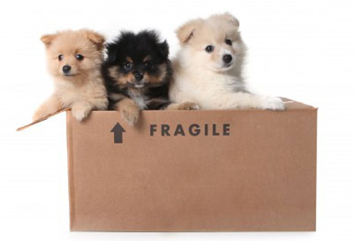Helping Fido Adjust to New Surroundings
As we’re propelled into these summer months, many changes and transitions often accompany the warmer weather. Whether you’re relocating for work, moving after graduation, or just planning a long summer vacation, here are some tips to help ensure that pets comfortably adjust to your new surroundings.

Prior to the move, it is important that you check the new surroundings for safety hazards such as hardware, chemicals, exposed wires, or other dangers. “It is also smart to make sure to have a safe place to put them when you get there, such as a closed off room or area with water, food, and shelter,” said Dr. Stacy Eckman, a lecturer at the Texas A&M College of Veterinary Medicine & Biomedical Sciences. “Doors opened often for moving in may be a tempting way out for anxious pets.”
Due to the chaos of moving, a microchip or other form of identification for your pet is highly recommended, in case they do sneak off unknowingly. “A microchip is nice because it cannot be lost, but visible identification is also helpful if they get out and become lost, since they are unsure of their new surroundings,” said Eckman.
If you’re traveling to your destination by plane, it is a good idea to speak with your veterinarian beforehand about the travel specifics. How long will the trip take? How does your pet normally do during travel? Will your pet be in cargo or in the cabin with you? Questions such as these can be discussed with your veterinarian to ensure that your pet is as comfortable and safe as possible during travel.
“All pets will also need a health certificate to travel, even across state lines,” said Eckman, “and those moving internationally will need an international health certificate which takes more time to acquire.”
Our pets thrive on routine, and since most everything else their daily routine will be changing, it is important that your presence does not. Once you’ve settled into your new location, be sure to spend plenty of time with Fido to help him acclimate to his new life.
“Often, pets are nervous and anxious with all the activity and boxes, as well as the new smells and sounds,” said Eckman, “so frequent walks around the neighborhood are a good way to help them get used to their new surroundings.”
Just as it takes people a certain amount of time to get used to a new routine, location, and way of life, the same goes for our pets. However, unlike us, they are unable to vocalize their discomfort and anxiety. As good pet owners, it is important that we do all that we can to make moving as comfortable as possible for our pets. This means keeping Fido safe and at ease before, during, and after the move, and most importantly, showing him that amidst all of the changes, he isn’t losing you.
Pet Talk is a service of the College of Veterinary Medicine & Biomedical Sciences, Texas A&M University. Stories can be viewed on the Web at vetmed.tamu.edu/news/pet-talk. Suggestions for future topics may be directed to editor@cvm.tamu.edu.


